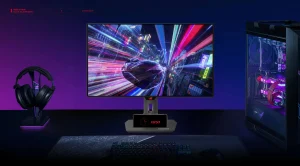The ASUS ROG Swift PG27AQDM is a gaming monitor that promises not only stunning visuals but also a competitive edge for gamers.
With its 27-inch display and 240Hz refresh rate, this monitor is designed to deliver a smooth and immersive gaming experience. However, to truly harness its potential, you need to tweak and fine-tune its settings.
In this comprehensive guide, we will walk you through the best settings for the ASUS ROG Swift PG27AQDM, whether you’re using it for gaming or general desktop applications.
Table of Contents
Getting Started
Before delving into the specifics, it’s crucial to ensure your monitor is set up correctly from the get-go. Here are the initial steps:
- Power Setting: Begin by accessing the system setup section. Here, confirm that the power setting is configured to “standard.” This selection is crucial as it grants you full control over the monitor’s brightness range. During the initial setup, you might be prompted to choose between different power modes. Opt for “standard” to ensure optimal control.
- Auto SDR Brightness: Decide whether you want to enable auto SDR brightness. This feature empowers the monitor to dynamically adjust brightness based on your room’s lighting conditions. You can activate the ambient light sensor built into the top of the screen for this purpose. If you prefer manual control, leave this feature turned off.
- HDR Warning Message: To avoid an annoying pop-up warning when transitioning to HDR mode, disable the HDR warning message.
Optimizing for Gaming
The ASUS ROG Swift PG27AQN is a gaming behemoth, and its settings should reflect that. Here’s what you need to configure in the gaming section:
- Overdrive (OD): Keep OD set to “normal.” This is the optimal mode for a fixed refresh rate, external input devices, or variable refresh rate (VRR) situations. Ensure that you’ve updated your monitor’s firmware to the latest version available on the ASUS product website for improved overdrive performance.
- Game Plus: Within this section, you’ll find features like the FPS counter and crosshairs. You can enable these features if you find them beneficial for your gaming experience. Otherwise, leave them turned off.
- Preset Modes: The monitor allows you to configure preset modes to match your preferences. While the default “racing mode” is a solid starting point, feel free to customize it to align with your unique gaming style.
- Dark Boost: Unless you’re playing particularly dark games or need to enhance details in darker scenes, it’s best to leave Dark Boost turned off. Note that enabling it may slightly affect your black depth.
- NVIDIA ULMB2: If you’re using an NVIDIA graphics card and desire improved motion clarity, consider enabling NVIDIA ULMB2. This feature activates the blue reduction backlight. Use the ULMB2 pulse width setting to fine-tune screen brightness to your liking. Keep in mind that this feature should be enabled exclusively for dynamic content like games.
Perfecting Image Settings
Optimizing image settings is pivotal for an enjoyable viewing experience, whether you’re gaming or working. Here’s how to configure the image section:
- Brightness: Adjust the brightness to your preferred level. A setting of around 120 nits is a comfortable starting point. Refine it based on the lighting conditions in your room and your personal preference.
- Contrast: Leave the contrast setting as it is; the default setting is generally adequate.
- Variable Backlight: Disable variable backlight for SDR and general usage to prevent local dimming activation.
- Blue Light: Maintain the blue light setting at level zero. If you use the monitor in low-light conditions or for extended reading sessions, you can increase this setting. However, remember to turn it off when it’s no longer needed.
- Display Color Space: You have the flexibility to switch between sRGB and wide gamut modes. The sRGB mode provides the most accurate performance for typical desktop and SDR content. In contrast, the wide gamut mode delivers a more vivid and saturated appearance. Choose the mode that aligns with your preference and usage.
Fine-Tuning Color Settings
Accurate colour representation is vital, especially for professionals and gamers who demand top-notch visual quality. Here’s how to configure the colour section:
- Colour Temperature: Set the colour temperature to 6500K, closely matching the D65 white point. This setting is ideal for accurate colour representation.
- Gamma: Retain the gamma setting at 2.2, as it closely aligns with the desired 2.2 gamma curve.
- Default Color Space: Keep the default colour space set to 6500K for precise colour reproduction. There’s typically no need to adjust the RGB channels unless you have specific requirements.
Best HDR Settings
The ASUS ROG Swift PG27AQN also supports HDR content, elevating your viewing experience to a whole new level. Here’s how to set it up:
- Enable HDR in Windows: Ensure that HDR is enabled in your Windows settings to unlock the full potential of HDR content.
- Variable Backlight: In HDR mode, variable backlight has a distinct control setting. Keep this feature turned on and experiment with the available settings to fine-tune your preferences. The three available settings offer different transitions; choose the one that best suits your taste.
- Colour Temperature: For HDR content, maintain the colour temperature at 6500K to ensure accurate colour representation.
- HDR Warning Message: As with SDR mode, disable the HDR warning message to eliminate interruptions when making adjustments in HDR mode.
Conclusion
The ASUS ROG Swift PG27AQDM is a versatile gaming monitor that can cater to a wide range of needs, from gaming to professional work. By following the recommended settings outlined in this guide, you can unlock its full potential and enjoy a visually stunning and responsive display for all your activities.
Remember that individual preferences may vary, so don’t hesitate to make further adjustments to suit your unique requirements. Whether you’re diving into intense gaming sessions or working on graphic design projects, your ASUS ROG Swift PG27AQDM can be tailored to provide the best experience possible.











